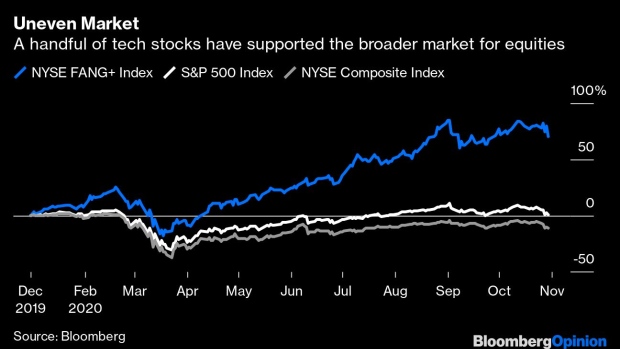Nov 2, 2020
The Nifty Fifty Have a Message for the Tech Obsessed
, Bloomberg News

(Bloomberg Opinion) -- Even with its biggest weekly setback since the early days of the Covid-19 pandemic in March, a small group of technology-related stocks remain well up for the year, as evidenced by the 70% gain in the NYSE FANG+ Index. This select group of 10 companies consists of such household names as Facebook Inc., Amazon.com Inc., Netflix Inc. and the parent of Google (hence “FANG”). The broader market isn’t doing as well, with the S&P 500 Index up only around 1% for the year and the New York Stock Exchange Composite Index down some 11%.
Sure, there are plenty of reasons for the explosion in these stocks. The companies are forecast to have huge earnings in future years, which when discounted back to the present at today’s low interest rates results in large numbers that many believe justify the lofty stock prices. The risk-free 10-year Treasury note yields about 0.85%, and with that as the discounting rate, $1 in earnings 10 years out is worth 92 cents today, almost 50% more than the 61 cents if that discounting rate were 5%. The same concept is imbedded in substituting earnings yields, which is the inverse of sky-high price-to-earnings ratios. For the S&P 500 Index as a whole, the 3.8 earnings yield looks much cheaper in relation to Treasury security yields rates than its 26 P/E ratio.
FANG mavens also note that these businesses are relatively independent of the basic economy, which looks to drop well into 2021 as the pandemic intensifies and spreads. In fact, these companies benefit as people work from home, order goods online, play computer games and watch movies. Then there is the TINA argument -- There Is No Alternative – with bond yields so low. I’ve never understood why investors buy stocks for appreciation but assume there is none in bonds. But as Treasury 30-year bond yields dropped from 14.6% in 1981 to a recent 1.64%, the resulting price appreciation was the key reason that total return for Treasury bonds have beaten the S&P 500’s total return by 5.5 times since the early 1980s.
If I’m correct in forecasting a prolonged, deep recession with escalating global deflationary pressures, the 30-year Treasury yield could easily return to the 0.98% low on March 9, representing a 19% total return over one year. Meanwhile, the S&P 500 could drop 30% to 40% as disappointing earnings combine with plummeting P/E ratios.
Read More: Deflationary Trends Are Growing More Powerful
Most important, investors’ focus on a small group of tech companies implies trouble ahead for all equities. That clearly was the case with the Nifty Fifty stocks that riveted investors’ attention in the 1960s and early 1970s. These equities represented rapidly-growing companies, some based on solid long-term growth prospects, while others were simply fads. Overconfidence became so extreme they were labeled “one decision” stocks. They had so much promise that investors only needed to make one decision—to buy them—since they would never need to be sold.
Nevertheless, disappointments began to multiply and the favored few shrank to motor homes (Winnebago), hamburger chains (McDonald’s), amusement parks (Disney) and gimmick cameras (Polaroid). They represented the limbs and outward flourishes of the economy, not the basic guts. By shunning the rest, investors should have anticipated big trouble. The 1973-1975 recession resulted in what was then the deepest since the 1930s, and what was left of the Nifty Fifty collapsed. Panicked investors lopped a zero off of Polaroid’s stock price, as it fell from $140 to $14.
Then there was the dot-com equity dominance that preceded the tech collapse in 2000, the bank stock bonanza that peaked in 2006 and energy stocks that plunged along with crude oil prices after leaping to a new high share of the S&P 500 in 2008.
Read more: Stock Traders Are In Need of a History Lesson
Another sign of equity investor discrimination in favor of tech stocks is their rejection of steady dividend payers, even though low interest rates should make attractive these 65 companies that have at least 25-year records of paying and increasing dividends. The S&P 500 Dividend Aristocrats Index yield of 2.7% tops the S&P 500 dividend yield of 1.7% and is more than triple the yield on the 10-year Treasury note. Nevertheless, investors have yanked more than $40 billion from dividend-focused mutual funds this year following their $3 billion withdrawal in the same period of 2019. That index is down 4.47% year-to-date.
As the many examples of earlier speculations show, investors’ flights of fancy ultimately collapse, leaving many poorer investors gnashing their teeth. Nevertheless, speculative periods often last for longer and go much further than rational analysis suggests. That’s because they have left the realm of reality for the land of zeal, hope and imagination that has no logical limits.
Speculations require a continual influx of true believers that move stock prices from the basis of reality to the stratosphere of hope. They end when the pool of new entrants is exhausted, often due to a shock of reality. Washington’s zeal to curb the power of certain tech companies may be that shock. Note that the NYSE FANG+ Index is already down 8% from its Sept. 2 peak.
This column does not necessarily reflect the opinion of the editorial board or Bloomberg LP and its owners.
A. Gary Shilling is president of A. Gary Shilling & Co., a New Jersey consultancy, a Registered Investment Advisor and author of “The Age of Deleveraging: Investment Strategies for a Decade of Slow Growth and Deflation.” Some portfolios he manages invest in currencies and commodities.
©2020 Bloomberg L.P.





